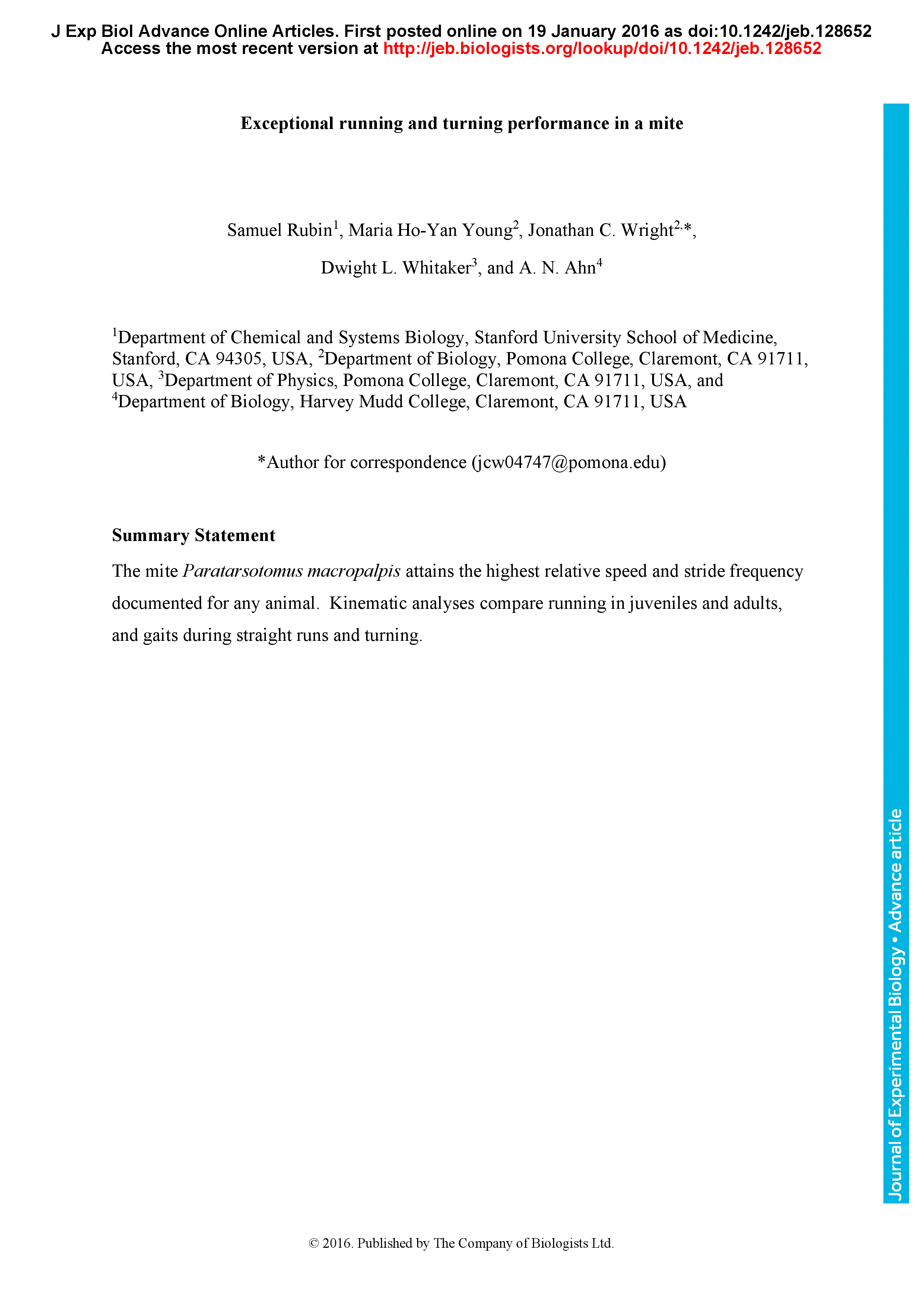The Southern California endemic mite, Paratarsotomus macropalpis, was filmed in the field on a concrete substrate and in the lab to analyze stride frequency, gait, and running speed under different temperature conditions and during turning. At ground temperatures ranging from 45°C to 60°C, mites ran at a mean relative speed of 192.4±2.1 BL s−1 (body lengths per second), exceeding the highest previously documented value for a land animal by 12.5%. Stride frequencies were also exceptionally high (up to 135 Hz), and increased with substrate temperature. Juveniles exhibited higher relative speeds than adults and possess proportionally longer legs, which allow for greater relative stride lengths. Although mites accelerated and decelerated rapidly during straight running (7.2±1.2 ms−2 and −10.1±2.1 ms−2, respectively), the forces involved were comparable to those found in other animals. P. macropalpis employs an alternating tetrapod gait during steady running. Shallow turns were accomplished by a simple asymmetry in stride length. During tight turns, mites pivoted around the tarsus of the inside third leg (L3), which thus behaved like a grappling hook. Pivot turns were characterized by a 42% decrease in turning radius and 40% increase in angular velocity compared to non-pivot turns. The joint angle amplitudes of the inner L2 and L3 were negligible during a pivot turn. While exceptional, running speeds in P. macropalpis approximate values predicted from inter-specific scaling relationships.
Exceptional running and turning performance in a mite
Currently Viewing Accepted Manuscript - Newer Version Available
Samuel Rubin, Maria Ho-Yan Young, Jonathan C. Wright, Dwight L. Whitaker, A. N. Ahn; Exceptional running and turning performance in a mite. J Exp Biol 2016; jeb.128652. doi: https://doi.org/10.1242/jeb.128652
Download citation file:
Advertisement
2023 JEB Outstanding Paper Prize shortlist and winner

The JEB Editors are delighted to announce the shortlisted authors for the 2023 JEB Outstanding Paper Prize. Read the winning paper - Tiny spies: mosquito antennae are sensitive sensors for eavesdropping on frog calls - by Hoover Pantoja-Sanchez and Brian Leavell from Ximena Bernal's lab at Purdue University, USA.
JEB Science Communication Workshop for ECRs

If you’re an early-career researcher interested in science communication and are attending the SEB Annual Conference in Prague this summer, come a day early and join the JEB Editors at a sci comm workshop to learn the key writing skills needed to promote your research to a broad audience beyond your peers (1 July at 14.30-17.30). Places are limited to 24 attendees, and applicants should apply through the SEB registration page by 30 April 2024.
Bridging the gap between controlled conditions and natural habitats in understanding behaviour

Novel technologies enable behavioural experiments with non-model species, in naturalistic habitats and with underexplored behaviours. In their Commentary, Scholz and colleagues discuss how to obtain a deeper understanding of the natural ecology and lifestyle of study animals.
Beluga metabolic measures could help save species

To help save animals from extinction, it’s important to understand what each species needs to survive. This led Jason John et al. to measure the metabolic rates of captive belugas to develop a ‘fish calculator’ showing that the whales need to eat ~23 salmon per day.
ECR Workshop on Positive Peer Review

Are you an ECR looking for tips on how to write concise, astute and useful manuscript reviews? If so, join the JEB Editors at a 2-hour JEB-sponsored Workshop on Positive Peer Review at the Canadian Society of Zoologists annual meeting in Moncton on 9 May 2024 at 13.00-15.00. There are 25 spaces for ECRs and selection is first come, first serve. To sign up, check the ECR Workshop box when you register for the CSZ meeting.



